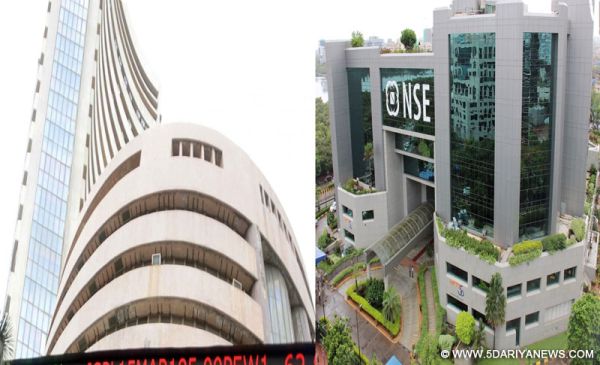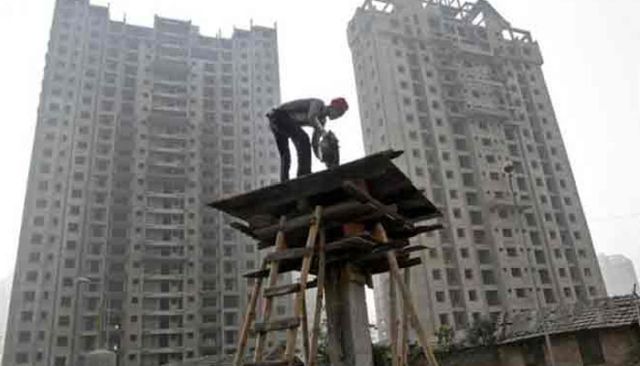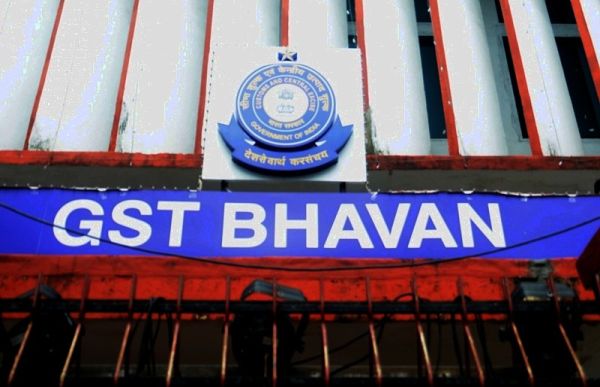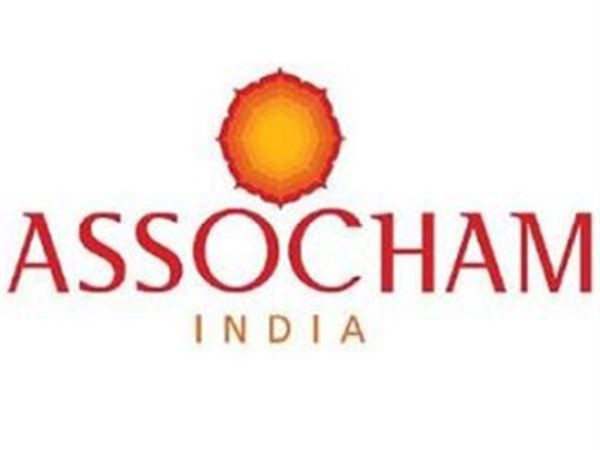
by admin | May 25, 2021 | Economy, Markets, News
 Mumbai : Key Indian equity indices on Friday closed the last trading day of calendar year 2017 on a higher note as positive global cues, along with a strong rupee and healthy buying in auto, IT and consumer durables stocks gave a boost to investors’ sentiments.
Mumbai : Key Indian equity indices on Friday closed the last trading day of calendar year 2017 on a higher note as positive global cues, along with a strong rupee and healthy buying in auto, IT and consumer durables stocks gave a boost to investors’ sentiments.
On a closing basis, the broader Nifty50 of the National Stock Exchange (NSE) rose by 52.80 points or 0.50 per cent to 10,530.70 points.
The barometer 30-scrip Sensitive Index (Sensex) reclaimed the important 34,000-level and closed at 34,056.83 points — up 208.80 points or 0.62 per cent — from its previous session’s close.
The BSE market breadth indicated a bullish trend as 1,562 stocks advanced as compared to 1,213 declines.
“Markets surged higher on Friday after two sessions of negative closings. It was the first trading session of the January 2018 derivative series and it was the last trading session of the year 2017,” Deepak Jasani, Head, Retail Research, HDFC Securities, told IANS.
“The rally came on the back of positive global cues. Broad market indices like the BSE mid-cap and small-cap indices gained more, thereby outperforming the main indices,” he added.
The S&P BSE mid-cap index closed higher by 0.74 per cent and the small-cap index by 0.64 per cent.
Vinod Nair, Head of Research, Geojit Financial Services, said: “Market surprised the investors with a positive note on the final trading day of 2017. Expectation of a pick up in third quarter earnings and strengthening of rupee supported the sentiment.”
“Focus on upcoming union budget and government’s reforms will direct investors to turn sector/stock specific. We feel that though the outlook on main indices is moderate in the short to medium-term, the broad market will maintain its vibrancy as businesses flourish,” he added.
On the currency front, the Indian rupee strengthened by 21 paise to close at 63.87 against the US dollar from its previous close at 64.08.
Provisional data with the exchanges showed that foreign institutional investors purchased scrips worth Rs 595.04 crore while domestic institutional investors bought stocks worth Rs 461.37 crore.
Sectorwise, the S&P BSE auto index rose by 306.74 points, followed by consumer durables index by 191.32 points and IT index by 134.27 points.
On the other hand, the S&P BSE oil and gas index fell by 75.45 points, metal index by 66.12 points and energy index by 12.46 points.
Major Sensex gainers on Friday were: Tata Motors, up 3.06 per cent at Rs 431.20; Tata Motors (DVR), up 2.99 per cent at Rs 244.80; Axis Bank, up 2.74 per cent at Rs 562.40; Tata Consultancy Services, up 2.72 per cent at Rs 2,700.40; and Hero MotoCorp, up 2.38 per cent at Rs 3,802.
Major Sensex losers were: Dr. Reddy’s Lab, down 0.71 per cent at Rs 2,414.40; Reliance Industries, down 0.36 per cent at Rs 921.05; Tata Steel, down 0.30 per cent at Rs 732.45; Bharti Airtel, down 0.20 per cent at Rs 530; and HDFC Bank, down 0.19 per cent at Rs 1,871.
—IANS

by admin | May 25, 2021 | Economy, News
 By Arul Louis,
By Arul Louis,
New York : India will “leapfrog” Britain and France to become the world’s fifth largest economy in 2018, ahead of an oncoming major global economic shift towards Asia, according to a British research organisation.
The World Economic League Table (WELT) 2018 released on Monday by Centre for Economics and Business Research (CEBR) said that in dollar terms India will rise from its seventh rank to overtake those European economies next year despite the stumble of demonetisation and the introduction of Goods and Services Tax (GST).
“The World Economic League Table shows that despite temporary setbacks from demonetisation and the introduction of the new GST tax, India’s economy has still catch up with that of France and the UK and in 2018 will have overtaken them both to become the world’s fifth largest economy in dollar terms,” said CEBR Deputy Chairman Douglas McWilliams.
The CEBR projections give India the fifth spot a year ahead of the International Monetary Fund estimates, which move it up in 2019.
According to the IMF, the size of India’s economy is currently $2.439 trillion. With an annual growth rate of 6.7 per cent in 2017 and 7.4 in 2018, it expects the size of India’s economy to be $2.926 trillion in 2019, when it will pull ahead of France and Britain according to its projections.
The world’s largest economies now are the US ($19.362 trillion), China ($11.937 trillion), Japan ($4.884 trillion), Germany ($3.652 trillion), France ($2.575 trillion), Britain ($2.565 trillion) and India, according to the IMF.
CEBR charts a trend of global economic shift to Asia.
“The interesting trend emerging is that by 2032, five of the 10 largest economies will be in Asia, while European economies will be falling down the ranking and the US will lose its top spot,” CEBR Senior Economist Oliver Kolodseike said.
According to WELT estimate, by 2032 three out of the world’s four largest economies will be Asian – China, India and Japan.
Korea and Indonesia are expected to join list of the world’s top 10 economies, with Taiwan, Thailand, Philippines and Pakistan making the top 25 list.
Construction activities are expected to get a tremendous boost, mainly because of India and China, according to CEBR.
“Construction’s share of world GDP is to reach its highest level ever, driven by ultra large global transformational projects,” Graham Robinson, director of Global Construction Perspectives, said.
“The Chinese Belt and Road Initiative and the Indian infrastructural project will boost construction’s share of world GDP to 15 per cent by 2032, probably the highest share of world GDP construction has seen since the pyramids or Great Wall of China were built.”
(Arul Louis can be reached at arul.l@ians.in)
—IANS

by admin | May 25, 2021 | Economy, Markets, News
 By Biswajit Choudhury,
By Biswajit Choudhury,
New Delhi : The 70th year since Independence will go down in Indian history since the country switched over to the Goods and Services Tax (GST) regime, realising, thereby, the vision of a unified market in a federal system that guided the nationalist bourgeoisie in joining Mahatma Gandhis struggle to liberate India from the British.
Of course, the structural reform came accompanied with pain for trade and industry caught off-guard by the rigours of new compliance procedures. Queried by corporate leaders at industry chamber Ficci’s 90th AGM here earlier this month on how GST was impacting through lower tax collections, Finance Minister Arun Jaitley put the onus on them.
“It is you from industry, who have been calling for so long to bring GSTÂ… and no sooner do these initial problems in implementing a reform of such scale appear, then you want to go back to the system we’ve had for 70 years,” he said.
The earlier system was a myriad of central and state taxes where the movement of goods was slowed down by products being taxed multiple times and at different rates.
State level taxes replaced by the pan-India GST include state cesses and surcharges, luxury tax, state VAT, purchase tax, central sales tax, taxes on advertisements, entertainment tax, various forms of entry tax, and taxes on lotteries and betting.
Central taxes replaced by GST are service tax, special additional customs duties (SAD), additional excise duties on goods of special importance, central excise, additional customs duties, excise on medicinal and toilet preparations, additional excise duties on textiles and textile products, and cesses and surcharges.
The new indirect tax regime unifying the Indian market has four tax slabs of 5, 12, 18 and 28 per cent.
It has a novel feature whereby goods and services providers get the benefit of input tax credit for the goods used, effectively making the real incidence of taxation lower than the headline taxation rate.
The second half of the year saw a radical reworking of the items within the four-slab tax structure by the supremely federal institution of the GST Council, whereby all but 50 of over 1,200 items remained in the highest 28 per cent bracket. Those retained included luxury and sin items, the cess on which goes to fund the compensation to states for the loss of revenue arising from implementing GST.
With the Council’s decisions last month, GST has been cut on a host of consumer items such as chocolates, chewing gum, shampoos, deodorants, shoe polish, detergents, nutrition drinks, marble and cosmetics. Luxury goods such as washing machines and air conditioners have been retained at 28 per cent.
Eating out has become cheaper as all restaurants outside high-end hotels charging over Rs 7,500 per room will uniformly levy GST of five per cent. The facility of input tax credit for restaurants has, however, been withdrawn as they had not passed on this benefit to consumers.
Petroleum, including oil and gas, is a strategic sector that is still not under GST, while the industry has been pushing for its inclusion so as not to be deprived of the benefits of input credit.
Including real estate is another matter pending before the GST Council.
On the functioning of the Council, Jaitley who is its head, had this remarkable insight about the way in which it had effected such large-scale rationalisation of the item rates in a short span of “3-4 months”.
“Everything has been achieved by consensus in the best spirit of cooperative federalism. There has been no politics, even from states which are controlled by opposition parties,” he told a gathering of industry leaders here.
The other side of GST was revealed through what the International Monetary Fund described as “short-term disruptions”.
With businesses going into a “de-stocking” mode on inventories in anticipation of the GST rollout from July and sluggish manufacturing growth, among other factors, pulled down growth in the Indian economy during the first quarter of this fiscal to 5.7 per cent, clocking the lowest under the Narendra Modi dispensation. Breaking a five-quarter slump, a rise in manufacturing sector output, however, pushed the growth rate higher to 6.3 per cent during the second quarter (July-September) of 2017-18.
Besides, technical glitches appearing on the GST Network portal, often unable to take the load of last-minute rush to file returns, marred the filing of returns by traders, forcing the government to postpone filing deadlines several times. The glitches also led to export refunds piling up, resulting in a grave situation of cash crunch for exporters, whose working capital was getting blocked.
In the final analysis, the GST balance sheet is provided by Gita Gopinath, Professor of International Studies and Economies at Harvard University, who is also the economic adviser to the Kerala Chief Minister.
“GST is a real reform. It is a way of formalising the economy. It is a very effective way of ensuring tax compliance, making it harder to earn black money. I mean, nothing ever goes away completely, but it just makes it harder to make it happen,” Gopinath said in Mumbai earlier this month.
The icing on the cake came with the World Bank announcing earlier this year that India had jumped 30 places in its Ease of Doing Business rankings to get among the top 100 countries on the list. Though reforms in India’s direct tax regime figured among the parameters considered in evaluation, GST had not been taken into account by the multilateral agency since their cut-off date was June 30.
(Biswajit Choudhury can be reached at biswajit.c@ians.in)
—IANS

by admin | May 25, 2021 | Economy, Markets, News, Politics
 New Delhi : With government policies set to tilt more towards the “stress-ridden rural landscape” next year in the run-up to the 2019 Lok Sabha elections, the Indian economy may reach a 7 per cent growth in 2018 while recovering from the lingering effects of demonetisation and GST, industry chamber Assocham said on Sunday.
New Delhi : With government policies set to tilt more towards the “stress-ridden rural landscape” next year in the run-up to the 2019 Lok Sabha elections, the Indian economy may reach a 7 per cent growth in 2018 while recovering from the lingering effects of demonetisation and GST, industry chamber Assocham said on Sunday.
“After ‘disruptions’ from the lingering effects of demonetisation and GST roll-out, the Indian economy may reach a 7 per cent growth in 2018 with government policies tilting towards the stress-ridden rural landscape in the penultimate year before the Lok Sabha elections,” according to the industry body’s “Year-Ahead Outlook”.
“Against GDP growth of 6.3 per cent in the second quarter of 2017-18, the economic expansion may reach the crucial 7 per cent mark by the end of September 2018 quarter, while inflation may range between 4-5.5 per cent towards the second half of the next calendar year with the monsoon being a key imponderable,” it said.
Assocham President Sandeep Jajodia said the projections were based on the assumption of stability in government policies, good monsoons, pick-up in industrial activity and credit growth as also stability in the foreign exchange rates.
“The worries on account of crude oil shooting up are likely to abate, if there are no fresh geo-political shockers.”
According to the Assocham outlook, while the underlying bullish sentiment should continue to prevail in the Indian stock market in 2018, the returns on equity may not be as robust as in 2017.
“This is because the 2017 bull run has already factored in the return of growth steadiness in 2018 and the corporate earnings witnessing a pick-up,” it said.
The industry lobby said in the run-up to state assembly elections in several politically important states, the political economy is set to tilt towards the farm sector “which has been witnessing some stress”.
“The stress in the agriculture sector is traceable to lack of reforms in the rural economy. Despite political promises, several of the states have not been able to reform the APMC Act, which restricts farmers to sell their produce to a particular set of cartels.”
Assocham expects the forthcoming Union Budget to be “heavily tilted” towards the farmers while the industrial focus would be on sectors which create jobs.
“A realisation seems to be dawning that growth per se is not enough, the benefits must be seen in the form of higher employment. The year 2018 would see policies in this direction”, the statement added.
—IANS

by admin | May 25, 2021 | Corporate, Corporate finance, Corporate Governance, Economy, News, Politics

Amit Mitra
Kolkata : Raising concern on the mechanism for GST refund to exporters, West Bengal Finance Minister and GST Council’s member Amit Mitra said a parliamentary panel pointed out “no interface” among the GST Network (GSTN) and Directorate General of Foreign Trade (DGFT) electronic data interchange (EDI) systems.
He said delayed refund to exporters in GST regime would lead to job loss in the labour intensive export sectors.
Citing the parliamentary committee’s report, he said: “It has been noticed that there is no interface amongst GSTN and DGFT EDI systems. Even the training given to the officers on ground on issues like Letter of Undertaking (LUT) and related matters has not been adequate… it has been experienced that it is easy to pay tax but it is very difficult to get a refund.”
According to him, the problem lies in the refund delivery mechanism because of “manual” processing of refund application and the system becomes more “primitive”.
“I am deeply concerned on the GST matters vis-a-vis exports,” he said while addressing the Export Excellence Awards ceremony organised by the Federation of India Export Organisations on Thursday evening.
According to the report — Impact of Goods and Services Tax (GST) on Exports — by the parliamentary committee headed by Naresh Gujral, the refund of IGST paid on export goods and refund of Input Tax Credit (ITC) on goods exported under Letter of Undertaking (LUT)/ Bond in the month of July, August, and September, 2017 still remain pending.
As a result, huge amount of working capital has been reportedly locked up, thereby, severely hurting the businesses of exporters and affecting their ability to be competitive in international markets. The Committee notes that a sharp liquidity crunch has gripped the majority of exporters due to the blocking of funds, the report said.
“It (the delay in disbursing refund) means your capital is blocked. The committee’s report said the (quantum of) blocked capital (stuck up with the government for refunds) could be between 15-20 per cent of the working capital. Declining of the working capital would lead to losing of jobs by the workers,” he said.
Again, citing the report, Mitra said the Committee notes that in the month of October, there is an overall decline in the merchandise exports by negative 1.12 per cent vis-a-vis exports of October last year.
The Committee notes that during the period July-October there has been a drop in the exports in the sectors like readymade garments of all textiles, fruits and vegetables, carpets, handicrafts, gems and jewellery, and there has been some stagnation in the sectors like leather.
According to the report, the labour intensive sectors appear to have been adversely impacted in this brief period, he said.
Mitra said the GSTN is supposed to process 300 crore of invoices per month and the software system has to undergo a change.
—IANS

 Mumbai : Key Indian equity indices on Friday closed the last trading day of calendar year 2017 on a higher note as positive global cues, along with a strong rupee and healthy buying in auto, IT and consumer durables stocks gave a boost to investors’ sentiments.
Mumbai : Key Indian equity indices on Friday closed the last trading day of calendar year 2017 on a higher note as positive global cues, along with a strong rupee and healthy buying in auto, IT and consumer durables stocks gave a boost to investors’ sentiments.



